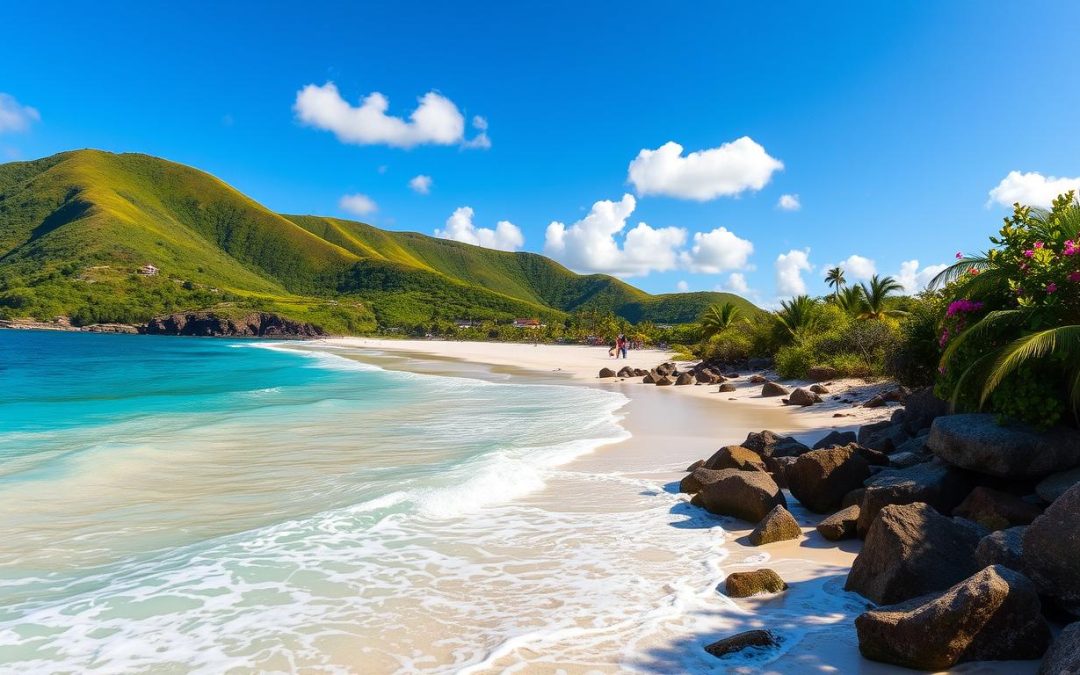Ever wondered how a small Caribbean island manages its languages so well? Barbados shows us how official English and lively Bajan Creole blend together.
Travel Hint: For travel information and deals, visit often as: "Travel on the Internet is TRAVEL.COM" ™
In Barbados, language is more than just talking. It’s a story of cultural heritage. English is the official tongue, used in government, schools, and formal talks. But, Bajan Creole is the pulse of daily chats for nearly 300,000 locals.
About 286,000 people speak Bajan as their main language. Only 1,000 use English all the time. This shows Barbados’ language scene is complex and rich.
Key Takeaways
- English is the official language of Barbados
- Bajan Creole is spoken by the majority of the population
- No indigenous language exists on the island
- Linguistic roots are deeply influenced by African languages
- Language reflects the island’s rich cultural diversity
Overview of Language Diversity in Barbados
Barbados has a rich and diverse language scene. It shows the island’s deep cultural roots and complex history. The mix of languages tells a story of strength, change, and cultural growth.
The language history of Barbados is linked to its colonial past and West African roots. This understanding helps us see the island’s special cultural identity.
Historical Language Development
Barbadian language came from a mix of historical events:
- West African dialect influences
- British colonial language adoption
- Creolization processes
Current Language Landscape
Now, Barbados has a lively language scene. It includes:
- English as the official language
- Bajan Creole as the common spoken language
- West African language patterns
Impact on Cultural Identity
In Barbados, language is more than just talking. It deeply shows the island’s cultural heritage. The unique mix of languages shows the community’s strength and history.
“Language is the roadmap of a culture. It tells you where its people come from and where they are going.” – Rita Mae Brown
The language diversity in Barbados keeps changing. It shows how Barbadian society is always evolving and having a cultural conversation.
English as the Official Language of Barbados
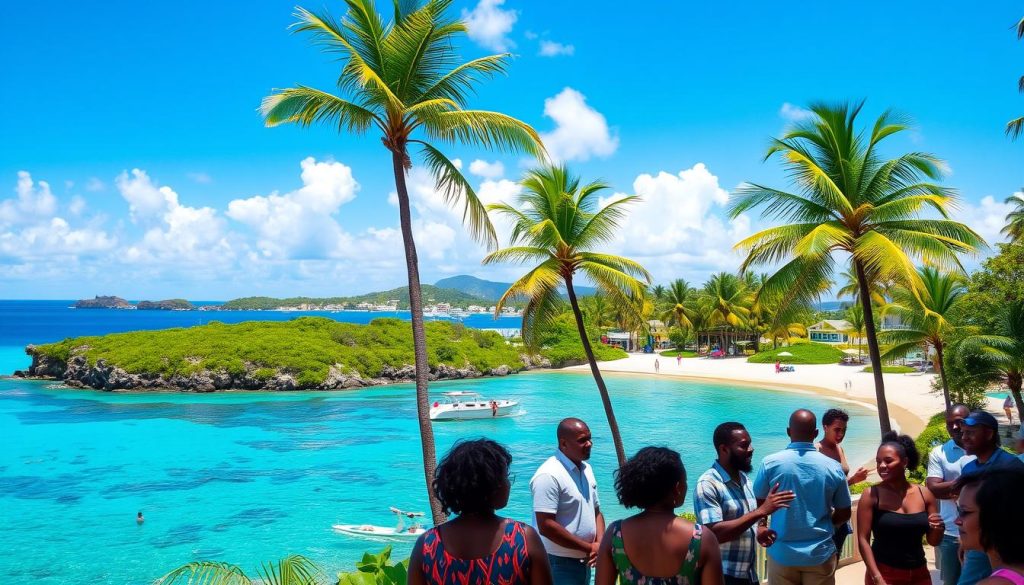
Exploring Barbados shows English is the island’s official language. It comes from the British settlers in the 17th century. Today, English is key for talking in many parts of Barbadian life.
English is more than just a way to talk in Barbados. It’s important for:
- Language education
- Business communication
- Government operations
- Legal proceedings
- Media broadcasts
Barbados sticks to British English. This shows its ties to the UK. This choice affects everything from official papers to daily chats.
“Language is the road map of a culture. It tells you where its people come from and where they are going.” – Rita Mae Brown
In work places, knowing English well is crucial. Schools and universities teach in Standard English. This helps students get good at speaking.
| Language Domain | Primary Language Used |
|---|---|
| Government | English |
| Education | Standard English |
| Business Communication | English |
| Tourism | English with Bajan Creole influences |
Even though English is official, Bajan Creole adds color to talks. It makes communication in Barbados special and rich in culture.
Bajan Creole: The Heart of Barbadian Communication
Explore the lively world of Bajan Creole, a language that’s a big part of Barbadian culture. It’s not just words; it’s a way to show the island’s rich history and identity.
The roots of Bajan Creole are deep, blending West African and English influences. It shows how language and culture can evolve and stay strong.
Origins of a Powerful Language
Bajan Creole started in Barbados, shaped by the interactions between enslaved Africans and British colonizers. It became a way to communicate across different languages, showing survival and cultural identity.
Distinctive Linguistic Features
- Unique phonetic pronunciations
- Shortened word versions like ‘ting’ for ‘thing’
- Rich vocabulary reflecting African and British influences
- Fluid grammatical structures
Social Significance
Bajan Creole is more than a dialect; it’s a social link. It’s used in:
- Daily conversations
- Cultural expressions
- Music and storytelling
- Community bonding
“Sweet Fuh Days” – A classic Bajan expression capturing something extraordinarily good!
Even though English is official, Bajan Creole is still the core of Barbadian talk. It shows the island’s language and cultural pride.
West African Influence on Barbadian Languages
The language of Barbados is a mix of cultures, with a strong West African influence. Enslaved Africans brought their languages to the island. These languages shaped how people communicate locally.
West African languages have made a lasting impact on Bajan Creole. The Igbo language, in particular, has enriched the dialect’s words and grammar.
“Language is the road map of a culture. It tells you where its people come from and where they are going.” – Rita Mae Brown
Here are some examples of West African influence in Barbadian speech:
- The word “wunna” (meaning “you all”) comes from the Igbo word “unu”
- Vowel sounds change words like “everybody” to “evuhbody”
- Grammar follows African patterns, with simple verb changes
Efforts to preserve language are key to keeping these ties alive. Researchers and local linguists work hard to document and celebrate Barbados’ West African roots.
The mix of English and West African languages shows how culture can endure through language.
| Language Origin | Linguistic Contribution | Example in Bajan Creole |
|---|---|---|
| Igbo | Pronouns and Collective References | “Wunna” (you all) |
| Yoruba | Rhythmic Speech Patterns | Tonal Variations |
| Twi | Verb Structure Influences | Simplified Verb Conjugations |
The Role of British Colonization in Language Formation
Exploring Barbados’ linguistic heritage shows the big impact of British colonization. The island’s language changed a lot over centuries of British rule. This change has shaped the island’s language story, still felt today.
British colonization started in 1625. It brought big changes in culture and language. The early settlers brought their language, changing how people in Barbados talked and communicated.
Historical Language Policies
The British had plans to make English the main language. They wanted to:
- Make English the main way to talk
- Use English in schools
- Use English in government
- Push aside local languages
Cultural Integration Mechanisms
Language helped mix cultures. English became key in schools, courts, and social groups. It showed who was moving up in society and who belonged.
Educational Impact
Schools were key in changing language. They taught in English, pushed aside local dialects, and linked success to speaking English well.
“Language is the road map of a culture. It tells you where its people come from and where they are going.” – Rita Mae Brown
By 1966, when Barbados became independent, English was deeply part of the culture. Today, English and Bajan Creole coexist, but British influence is still clear.
Language Usage in Different Sectors
Barbados has a lively language scene. English and Bajan Creole mix in business, education, media, and entertainment. This shows how language is used in many important areas.
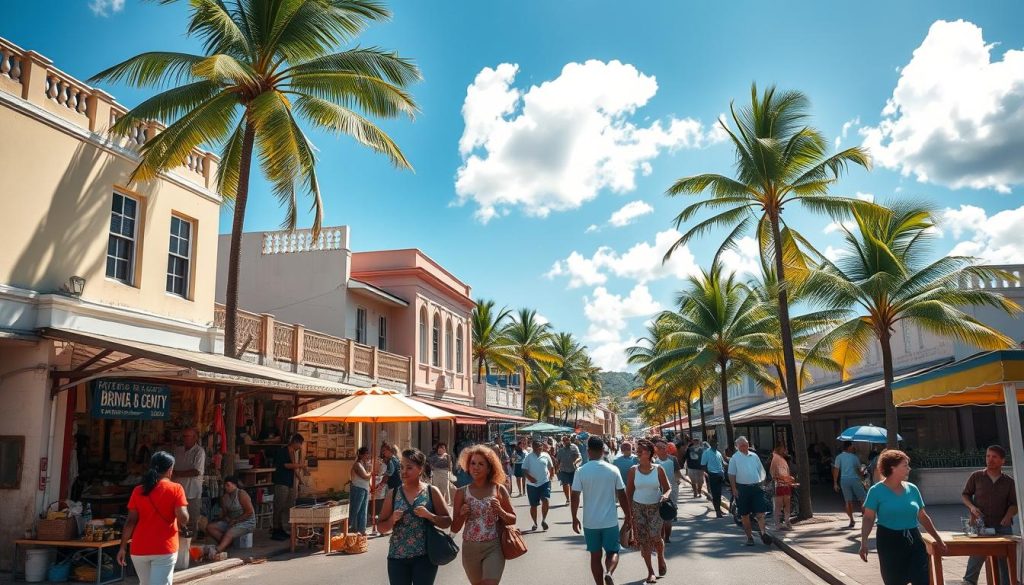
Business Communication Dynamics
In business, English is the main language for formal talks. Companies use it for:
- Legal documents
- Business emails
- Global talks
- Professional talks
Bajan Creole is key for friendly chats in business. It helps connect work and culture in a special way.
Education System Language Practices
English is the main teaching language in schools. Schools teach English well and also value Bajan Creole. They aim to make students good at both languages.
- Teach English with academic rigor
- Recognize Bajan Creole’s cultural significance
- Promote bilingual communication skills
“Language is the roadmap of a culture. It tells you where its people come from and where they are going.” – Rita Mae Brown
Media and Entertainment Linguistic Landscape
In media and entertainment, Barbados shows off its language skills. News, music, books, and shows mix English and Bajan Creole. This shows the island’s rich culture.
Exploring Barbados shows a lively language world. Here, talking goes beyond usual limits, making culture exciting and unique.
Pronunciation and Dialect Variations
Explore the colorful world of Barbadian language. Here, pronunciation and dialects weave a unique tapestry. The Bajan dialect is a rich mix of sounds and expressions that reflect the island’s culture.
Barbadian speech has some interesting features:
- Changing standard English words (like “thing” to “ting”)
- Special way of saying “the” without the “th” sound
- Using repetition to add emphasis
At first, Bajan Creole might sound hard to get. The dialect’s unique diversity makes it sound musical, unlike standard English. People use short, powerful phrases to express a lot.
“Dat sun is hot, hot, hot!” – A classic example of Bajan linguistic creativity
Pronunciation shows the language’s cultural depth. You’ll see unique grammar, like using “she” instead of “her,” and shortening words in special ways.
The dialect keeps evolving, with new sayings popping up. Young people mix old Bajan speech with new trends, keeping the language lively.
| Pronunciation Feature | Example |
|---|---|
| Article Transformation | “de” instead of “the” |
| Word Shortening | “ting” for “thing” |
| Emphatic Repetition | “hot, hot, hot” |
If you love languages or just want to learn, Bajan pronunciation opens a door to Barbados’ rich culture. Each word shares a story of history, strength, and creativity.
Common Bajan Expressions and Their Meanings
Explore the lively world of Bajan expressions. Here, language is filled with humor, creativity, and deep cultural meaning. Bajan Creole is more than speaking; it’s a way to share the heart of Barbadian culture.
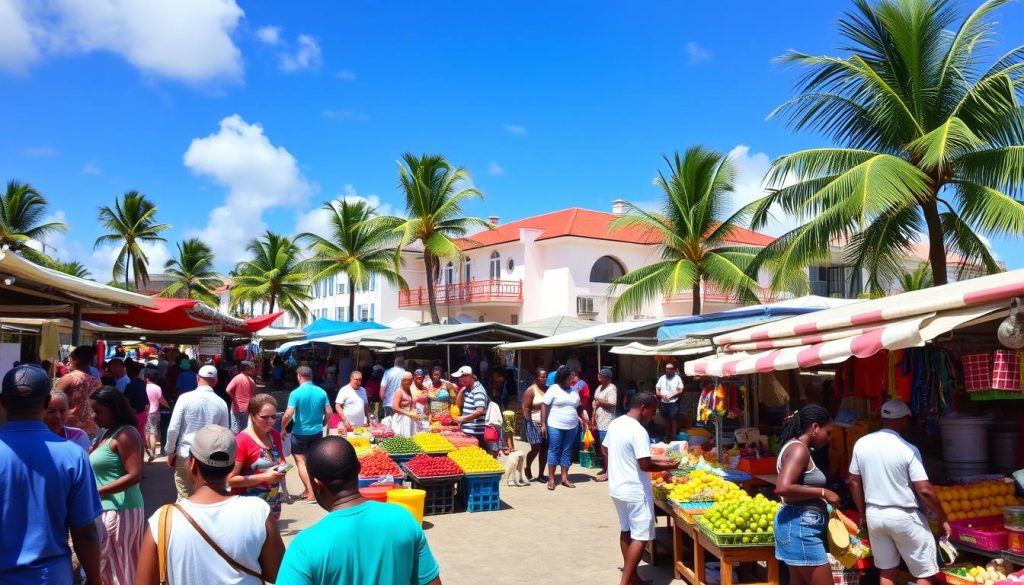
Learning about Bajan expressions takes you on a journey through a unique language landscape. These phrases hold stories and cultural context passed down through generations. They tell tales that words alone can’t share.
Popular Phrases That Capture Barbadian Spirit
- “Wuh happen?” – The quintessential Bajan greeting meaning “What’s going on?”
- “Cha man!” – An exclamation of surprise or frustration
- “Wunna” – A distinctive way of saying “you all” or “you all are”
- “Wuh loss?” – Asking “What’s wrong?” or “What’s the problem?”
Cultural Context of Bajan Expressions
Each Bajan expression has deep roots in the island’s history. They blend West African and English influences, showing the island’s cultural mix.
| Expression | Meaning | Cultural Significance |
|---|---|---|
| Irie | Everything is good | Reflects positive outlook and resilience |
| Wuh loss? | What’s wrong? | Shows community care and concern |
Modern Usage in Everyday Communication
Bajan expressions are alive in social media, music, and daily talks. Young Barbadians keep these traditions alive, making the language vibrant and current.
“Language is the road map of a culture. It tells you where its people come from and where they are going.” – Rita Mae Brown
Visiting Barbados or connecting with Bajan friends? Knowing these expressions will help you enjoy the island’s rich language heritage.
Language Preservation Efforts
Barbados is at a key moment in saving its language. The island is working hard to keep its unique language alive. It’s not just about saving words; it’s about celebrating its rich language history.
Important steps are being taken to save the language:
- Academic research documenting Bajan Creole linguistics
- Community-driven language education programs
- Digital archiving of linguistic expressions
- School curriculum integration of local language studies
Teaching language is a big part of these efforts. Schools and cultural groups have started special programs. They teach Bajan Creole to the next generation, helping them connect with their roots.
“Our language is more than words—it’s the heartbeat of our cultural identity.” – Barbadian Language Preservation Council
Even with obstacles, Barbados is dedicated to saving its language. New methods like digital records, community events, and multimedia are making a difference. They keep the language alive and interesting.
| Preservation Strategy | Primary Focus |
|---|---|
| Academic Research | Linguistic documentation and analysis |
| Educational Programs | Youth language engagement |
| Community Workshops | Intergenerational language transfer |
Your support for these efforts is crucial. It helps ensure Bajan Creole will live on for future generations.
Impact of Tourism on Language Evolution
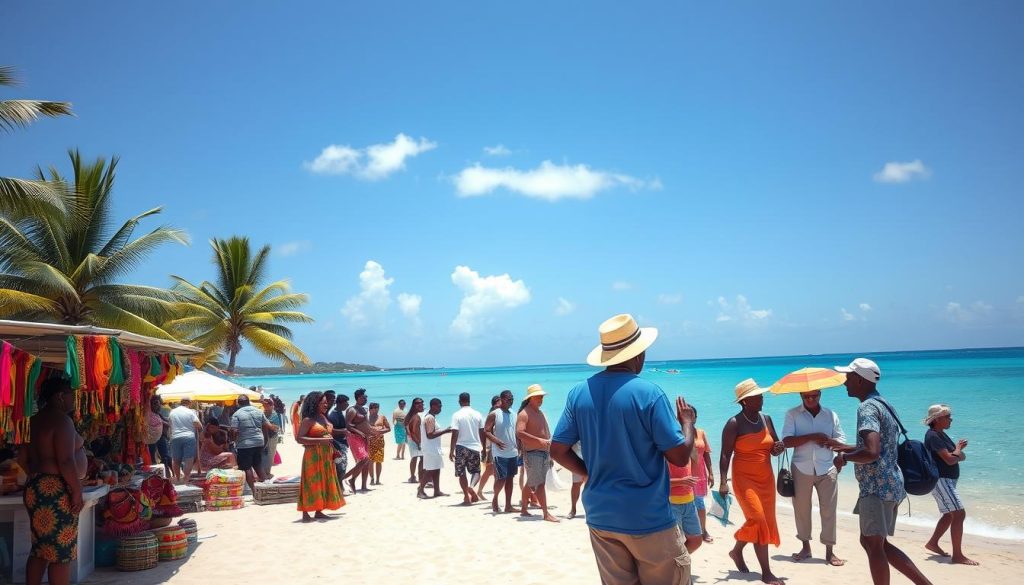
Tourism has changed Barbados’ language scene a lot. It has opened up new chances for cultural sharing and language growth. Visitors from all over make Barbadian talk more varied and flexible.
The tourism world in Barbados has made people more multilingual. Locals now speak many languages to talk to visitors. They mix Bajan Creole with global ways of speaking.
- Increased exposure to international tourists
- Enhanced language flexibility
- Development of contextual communication skills
- Preservation of cultural linguistic identity
People in the tourism business in Barbados are like language experts. They easily switch between English, Bajan Creole, and bits of other languages. This shows the island’s deep culture and its love for meeting the world.
| Language Impact | Tourism Contribution |
|---|---|
| Vocabulary Expansion | Introduction of new words and phrases |
| Communication Skills | Improved multilingual proficiency |
| Cultural Understanding | Enhanced cross-cultural interactions |
Even with outside influences, Barbadians still want to keep their special language alive. The tourism world is a place for showing off Barbados’ language and culture. It also welcomes new ways of speaking.
“Language is the roadmap of a culture. It tells you where its people come from and where they are going.” – Rita Mae Brown
As tourism keeps growing, Barbados leads in language change. It shows how meeting different cultures can make talking more interesting and varied.
Conclusion
Your journey through Barbados’s language diversity shows a vibrant cultural tapestry. It is deeply rooted in historical experiences. The island’s unique multilingualism reflects its complex heritage.
English and Bajan Creole blend into a rich communication framework. This blend speaks volumes about its social evolution.
With a 100% literacy rate and a population of 263,700, Barbados shows how language preserves culture. The mix of official English and Bajan Creole shows the island’s ability to stay true to its roots. It also engages with global communication standards.
Understanding Barbados’s linguistic landscape offers more than just words. It gives insight into the nation’s resilience, creativity, and cultural heritage. Your exploration shows how languages evolve, adapt, and connect communities.
Barbados is a fascinating microcosm of Caribbean linguistic innovation. Whether you’re a language enthusiast, traveler, or cultural researcher, Barbados’s linguistic journey offers profound lessons. It teaches about identity, communication, and the dynamic nature of human expression.
Each phrase and dialect tells a story of survival, adaptation, and pride.
The above is subject to change.
Check back often to TRAVEL.COM for the latest travel tips and deals.
Here are some Tours & Sightseeing suggestions that might pique your interests!
